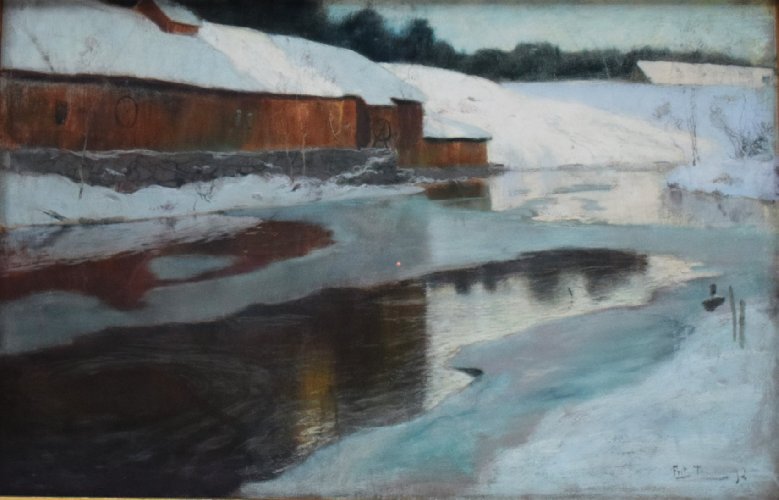Description:
Johan Frits Thaulow (1847-1906) studied at the Academy in Copenhagen and Karlsruhe. His creativity was greatly influenced by his visits to France, which encouraged him to establish the “Freilu-ftakademie” which was meant to fight against the academic painting traditions in Norway. He eventually moved to northern France and became a member of the Société Nationale des Beaux-Arts. The most recurring motif in his art was a river shown at different times of the day. He was particularly interested in the so-called “blue hour”, a brief moment at dusk when the world is tinted blue.
Description of the painting:
Most of the canvas is filled by a half-frozen river, in which the titular old factory is reflected. The river and the building are surrounded by snow-covered blue slopes, from which a dark strip of trees stands out above them. A narrow strip of sky visible above the trees almost repeats the colors of the frozen river, completing the composition of the painting.
It is no different with the Rogalinski painting “Old Factory”. Although the title building, with its wooden structure standing out against the white of snow, does indeed attract attention, the river frozen with ice takes up a larger part of the composition. The factory seen from the opposite bank is reflected in the calm, cold depths, where it seems to be darker and more ominous.
It is difficult to determine the time of day in the image. It is probably the artist’s favorite “blue hour”, which is the moment right after sunset or right before sunrise, when the colors of the surroundings seem to be saturated with a blue halo. This is particularly visible in the small fragment of the horizon cut off by the strip of trees from the white-blue slopes of the hills.
Frits Thaulow, a Norwegian landscape painter, graphic artist, and writer inspired by French landscape painting, the Barbizon school, and Impressionism, decided to translate these experiences into Scandinavian soil, where academic stiffness still prevailed. After several years of promoting Impressionism in Norway, he moved to Paris permanently, from where he often traveled to paint small towns and French villages.


